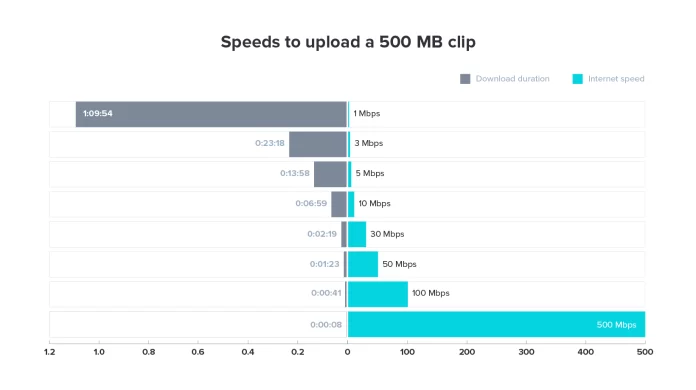It’s hard to imagine the life of a modern person without gadgets and Internet access. They provide society with opportunities for work, leisure, and study. This is why it is so important to have a stable Internet connection. In this article, you will learn about the optimal Internet connection speed in 2023 to understand whether you should use 4G or 5G signal boosters.
Table of Contents
What Home Internet Speed Is Considered Normal?
Normal Internet speed allows you to perform all tasks: communicate with colleagues via video conference, send emails, scroll through social media feeds, watch films without delays, and much more. That is why each user will have individual Internet speed values that can be considered normal.
Previously, it was believed that 15 Mbit/s was enough for one person. Today, speeds of 100 Mbit/s have become the standard. Why? Here are some reasons:
- Most people surf the Internet not only from a computer – they connect a smartphone, tablet, TV, smart speaker, robot vacuum cleaner, and much more to WiFi.
- Video quality has increased, even movies at maximum resolution require more than 15 Mbit/s.
- After 7 pm the speed often drops due to peak load. People come home from work, go on social networks, turn on a film, and communicate via video conference.
- Guests sometimes ask for a WiFi password and share the Internet with you for a while.
What Affects Speed Indicators
The value indicated by the provider in the tariff is not your real speed. The real one will depend on many factors – the load on the provider’s network at the moment, the type of your connection (wired or Wi-Fi), the number of devices connected to the router, and your distance from the server.
- Number of devices.
Speed depends on how many devices you connect to your home network and how you use those devices.
- Internet connection type.
There are several options for connecting to the network, the most popular of which are:
- Wired connection – the cable from the Internet provider is connected directly or from the router to a computer, laptop, or TV;
- Wireless connection – devices connect via Wi-Fi to a router or other Internet-distributing device;
- Mobile Internet – provided by your provider using a SIM card.
We recommend using the wired type, as it is the most stable and reliable. The only negative is the wire itself. During normal Internet operation, the indicators vary from 90% to 110% of your tariff plan.
Typically, a similar connection is used on:
- desktop computers for games, streaming;
- Smart TV for high-quality TV series and movies.
If you connect a cable, no one uses the Internet except you. The provider provides the required speed and the router works correctly. The actual speed is equal to the tariff plan. Average indicators are 95-110% of it.
A more convenient type of connection is wireless, in which the signal is transmitted via Wi-Fi, but it is necessary to take into account the functionality of the router, its distance from devices, and the frequency range.
- Router, distance and location.
The characteristics of the router directly affect the speed of the Internet – the frequency range of the Wi-Fi module (2.4 GHz, 5 GHz), the number and gain of antennas, transmitter power, etc. It is important to check them before choosing a tariff. If the throughput is lower than the speed declared by the tariff, you will not be able to take full advantage of the proposed speed.
In 2-3-room apartments, we recommend using several routers or installing a 4G or 5G signal booster.
If you use a wireless connection to a router that is located in the next room, then in addition to your device, others may be connected, because other family members also use the Internet. The actual speed is constantly changing and will be lower than the tariff plan. There are more factors to consider that affect speed. Wi-Fi may disappear, and the speed may drop to 5-10% of the tariff.
Another parameter that affects speed is the remoteness of the server. Services for content use special storage facilities – servers. The more popular the content, the lower the Internet speed you need. If you use a large platform like YouTube or Netflix, then even at a speed of 10 Mbps you will be able to watch Full HD quality without freezing, because such platforms have a well-developed server architecture.
What Internet Speed Is Needed For Work And Other Tasks?
Let’s look at the optimal speed for the most common tasks:
- Text information and mail.
1 Mbit/s incoming and outgoing speed is enough. Text is the “lightest” of the presented content types – 1 character weighs 1 byte. With a tariff plan of 1 Mbps, an article of 130,000 characters will load in 1 second. For text messages that you receive/send in instant messengers, this value will be more than enough.
- Audio – music, podcasts, books, voice messages.
Also, 1-2 Mbit/s incoming speed is sufficient with a stable connection. Music, like any information, has a certain weight. Previously, you had to download songs before listening to them. There are now quite a few services that allow you to listen to it online. On average, one song weighs 3-8 MB and lasts 2-5 minutes.
- Photo – Instagram, photo stocks.
To quickly display photos on Instagram or photo stocks, 5-10 Mbit/s incoming speed is enough. If the images are not optimised, they have a high resolution, then it will take some time to load – 2-20 seconds. Every photograph or picture on the Internet is a set of pixels. Depending on the resolution, format, and detail, their weight and loading time vary. A few examples:
- Resolution: HD, 1280×720. Weight: 0.2 – 0.65 MB. With a tariff of 5 Mbit/s, the download time for 1 file is less than 1 second.
- Resolution: Full HD, 1920×1080. Weight: 0.4 – 1.2 MB. At 10 Mbit/s, the download time for 1 file is less than 1 second.
- Resolution: Ultra HD (4k), 3840×2160. Weight: 2.2 – 3 MB. At 10 Mbit/s, the download time for 1 file is less than 2.5 seconds.
Wrapping It Up
Choose Internet speed according to your needs. The higher it is, the more expensive the tariff plan, and often it is not used to the maximum. Consider factors that affect speed – the way your devices connect to the Internet, their number, and distance from the server. To improve the 4G or 5G signal, we recommend using boosters. You can turn to UCtel, a company with impressive experience in boosting the signals of the most common British operators.









